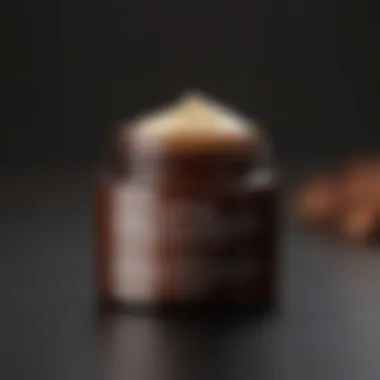Effective Ointments for Dark Spots on Face


Intro
Dark spots on the face can be a source of frustration for many. These irregular patches of pigment often appear due to sun exposure, hormonal changes, or aging. Understanding the nature of these spots is crucial in selecting an effective ointment for treatment. This article aims to demystify the factors contributing to dark spots and guide you through the best ointments available.
In today’s skin care landscape, many products promise to help reduce the appearance of hyperpigmentation. With the plethora of options, it is vital to identify what truly works. Recognizing the right ingredients, understanding how they work, and knowing the best application methods are fundamental to finding an ideal solution.
This guide will delve into the essential components to consider while identifying the best ointment for dark spots. Information will include tips on effective application, skin care routines, and a review of popular products. By the end, you will be well-equipped to make informed decisions for your skin care journey.
Understanding Dark Spots
Understanding dark spots is essential in addressing skin concerns effectively. Dark spots, also known as hyperpigmentation, can be a source of frustration for many individuals. This section provides insights into what causes dark spots and why they appear on the skin. Gaining a clear understanding allows readers to tailor their treatment options and skincare routines more effectively.
It is crucial to note that dark spots do not represent any severe skin condition, but they can impact one's self-esteem and make individuals self-conscious. Identifying the underlying causes is key to choosing the right ointment and ensuring efficacy in treatment.
What Are Dark Spots?
Dark spots are small patches of skin that become darker than surrounding areas. This is due to an excess production of melanin, the pigment responsible for skin color. They can appear in various forms, including freckles, age spots, or post-inflammatory marks from acne or injury. These marks can vary in size and shape, thus impacting the overall complexion.
Common Causes of Dark Spots
Dark spots can arise from a variety of factors, each linked to different aspects of skin health.
Sun Exposure
Sun exposure is a primary culprit in the formation of dark spots. Prolonged exposure to ultraviolet rays can lead to changes in the skin pigment. Over time, this damage accumulates, resulting in uneven skin tone and dark patches. The risk associated with sun exposure is significant; therefore, using sunscreen is indispensable in daily skincare. Lack of protection not only contributes to dark spots but can also lead to premature aging.
Aging
Aging naturally affects the skin, leading to the development of dark spots. As the skin matures, the cell turnover rate slows down, causing accumulations of pigment to become more noticeable. Age spots, or liver spots, typically appear on sun-exposed skin areas like the face, hands, and shoulders. They signify areas of prior sun damage and serve as reminders of the effects of long-term exposure to sunlight.
Hormonal Changes
Hormonal changes greatly influence skin pigmentation, particularly in women. Conditions such as pregnancy, menstruation, or the use of birth control can trigger melasma, a type of hyperpigmentation. This hormonal imbalance results in the overproduction of melanin, often creating symmetrical patches on the face. These changes can be particularly frustrating as they often appear suddenly, impacting confidence levels.
Post-Inflammatory Hyperpigmentation
Post-inflammatory hyperpigmentation occurs following skin trauma, such as cuts, burns, or acne. When the skin heals, the pigmentation can remain, resulting in dark spots. This condition indicates that the skin is sensitive and requires gentle treatment to avoid further irritation while fading the dark spots. People with darker skin tones are often more prone to this type of hyperpigmentation.
Understanding these causes provides a critical foundation for selecting appropriate ointments and treatments. Identifying the root of your dark spots can lead to targeted therapies that are more likely to serve your skin's unique needs.
The Importance of Choosing the Right Ointment
Selecting the appropriate ointment for dark spots is crucial for several reasons. First, there is a variation in skin types among individuals. The skin's reaction to certain ingredients can differ significantly. Therefore, understanding how specific ointments work can lead to more effective treatment outcomes. Proper ointment choice can not only enhance the appearance of the skin but also boost confidence and self-esteem. Moreover, employing a targeted approach can yield quicker results compared to generalized products that may not address the distinct causes of dark spots.
Another key aspect to consider is the long-term health of the skin. Using the right products can help prevent further pigmentation issues or irritation. Dark spots may not just be a cosmetic concern; they can indicate a larger health issue. Thus, suitable treatments manage not only the visible signs but also promote overall skin health, potentially reducing the recurrence of such conditions.
Additionally, a tailored approach allows individuals to align their skincare routine with their specific needs. Products containing active ingredients could cater better to those experiencing hormonal changes or skin aging. In essence, opting for the correct ointment can lead to a more successful and satisfying skincare journey.
Why Targeted Treatment Matters
Targeted treatment refers to using ointments formulated specifically for dark spots, emphasizing the need for precision in addressing the issue. Individuals who employ these specialized products often notice improvements faster compared to those who rely on generic solutions. This efficiency is primarily due to targeted active ingredients that are proven effective against hyperpigmentation. Ingredients such as hydroquinone and vitamin C play critical roles in lightening existing dark spots while preventing new ones from developing.
Moreover, targeted treatments can provide additional benefits like moisturizing or refining skin texture, which takes a holistic approach to skincare. By focusing on the specific nature of dark spots, people can realize improvements not just in pigmentation but also in overall skin condition.
In summary, using a targeted treatment allows users to deal directly with their specific skin concerns. This approach not only maximizes the effects of the treatment but also enhances the overall efficiency of their skincare regimen.
Potential Risks of Incorrect Products
Using the wrong ointment can lead to various adverse effects. For example, some products may contain harsh chemicals that can irritate sensitive skin or exacerbate existing skin conditions. Individuals who do not conduct proper research may find themselves using ointments that promise quick results but can lead to worse outcomes.
Additionally, certain ingredients might not be suitable for specific skin types. It is vital to recognize potential allergens or irritants that could provoke negative reactions. Educating oneself on ingredient lists is essential; this can prevent unwarranted side effects like redness, peeling, or breakouts.


Choosing the right product not only enhances treatment success but also safeguards the skin’s health. Misguided choices can derail progress and make skin issues even worse.
In essence, avoiding incorrect products is paramount in maintaining skin integrity and achieving desired results. Awareness and knowledge about suitable treatments play significant roles in successful skincare routines.
Key Ingredients to Look For
Choosing the right ointment for dark spots on the face hinges significantly on the ingredients contained within the product. Certain components possess the capability to specifically target hyperpigmentation, inhibit melanin production, or promote cellular turnover. Understanding these key ingredients can lead to more informed decisions and more effective outcomes in treatment plans. Here are five critical ingredients to consider when selecting an ointment for dark spots:
Hydroquinone
Hydroquinone is often deemed the gold standard for treating dark spots. This ingredient works by inhibiting the enzyme that helps produce melanin, therefore reducing pigmentation. Hydroquinone is effective for various types of hyperpigmentation including sun spots and melasma. It is important to use this ingredient under the guidance of a dermatologist, primarily due to potential side effects with prolonged use. Common side effects can include redness or irritation on the skin. Hence, keep usage to a recommended period and consult a dermatologist if you have concerns.
Vitamin
Vitamin C is a potent antioxidant known for its skin-brightening qualities. It helps to reduce the appearance of dark spots by inhibiting melanin production. Additionally, this nutrient aids in skin healing and can improve skin texture over time. Products containing Vitamin C often offer a refreshing sensation on application. However, the stability of Vitamin C can vary among formulations, which is why it’s essential to look for stable derivatives like ascorbic acid or magnesium ascorbyl phosphate to ensure effectiveness.
Retinoids
Retinoids are a class of compounds derived from Vitamin A, commonly used in skincare for their ability to promote cell turnover. They work effectively in diminishing the appearance of dark spots by accelerating the shedding of the uppermost skin layers, revealing a more even skin tone underneath. Retinoid products vary in strength, and over-the-counter formulations contain retinol, while stronger versions are available via prescription. Since retinoids can increase skin sensitivity, especially when first introduced into a routine, gradual incorporation is commonly advised.
Niacinamide
Niacinamide, also known as Vitamin B3, is increasingly recognized for its multifunctional benefits. It not only assists in reducing dark spots but also improves skin elasticity, enhances barrier function, and regulates oil production. This ingredient can effectively lighten hyperpigmentation without the irritation often associated with harsher products. Niacinamide is beneficial for various skin types, making it a versatile choice for individuals looking to address discoloration while promoting overall skin health.
Azelaic Acid
Azelaic Acid is a lesser-known ingredient that provides significant benefits for those with dark spots. It also works to inhibit melanin production while offering anti-inflammatory properties. This acid is particularly recommended for those with sensitive skin or conditions like rosacea. Azelaic acid is generally well tolerated and can be found in various concentrations, making it accessible to a broader audience. Its ability to help clear pores also makes it effective for preventing acne, thus offering dual benefits.
Choosing a product with the right ingredients is crucial for achieving the desired results in treating dark spots. A knowledgeable approach to these key compounds will empower you to make informed decisions for your skin's unique needs.
Top Ointments for Dark Spots
Choosing an effective ointment for dark spots is crucial for anyone looking to achieve a clearer complexion. Top ointments are formulated specifically to target pigmentation issues, such as dark spots, and providing treatment that not only diminishes their appearance but also addresses the underlying skin concerns. Several elements are significant when evaluating these products, including the active ingredients, ease of application, and the expected outcomes. Effective treatments can lead to noticeable skin improvements, enhancing confidence and overall skin health.
Product A Review
Ingredients Overview
Product A features a combination of hydroquinone and vitamin C. Hydroquinone is widely recognized for its skin-lightening properties, making it a go-to choice for those struggling with dark spots.
The key characteristic here is its potency in inhibiting melanin production, which can contribute to dark spots. Vitamin C complements this effect by providing antioxidant benefits, further protecting the skin from oxidative stress.
A unique aspect of this product is its dual-action formula that not only lightens existing spots but helps in preventing new ones from forming. However, some users may experience sensitivity to hydroquinone, which needs to be considered before use.
Usage Instructions
For optimal results, it is suggested to apply Product A once or twice daily. The key characteristic of these instructions is their simplicity, allowing for easy integration into any skincare routine. Users should cleanse the skin before application to ensure effective absorption.
The unique feature here lies in the recommended use during nighttime, as the skin undergoes repair processes while sleeping, boosting the efficacy of treatment. However, frequent application may cause irritation in some; therefore, it’s best to start gradually.
Expected Results
In terms of expected results, users can see noticeable improvements in their skin within four to six weeks of regular use. The product is designed to provide gradual lightening of dark spots, resulting in a more uniform skin tone.
A significant characteristic is that users often report improved skin texture as a secondary benefit. The consistent usage is fundamental, as results may vary; some may not see immediate changes, which can be disheartening but is essential to manage expectations.
Product B Review
Ingredients Overview
Product B incorporates niacinamide and retinoids. Niacinamide works effectively to brighten skin and even out tone. Its key characteristic is reducing inflammation, which can be beneficial for those with sensitive skin.


The unique feature of this formulation lies in the retinoids, which promote cell turnover and can enhance the effectiveness of niacinamide in fading dark spots. Although retinoids might result in initial dryness, they are widely recommended for long-term benefits in skin smoothness and clarity.
Usage Instructions
Recommended usage for Product B is every other night to allow skin to adjust to retinoids. The instructions emphasize a careful approach, acknowledging the sensitivity some users may experience when starting.
This unique feature can limit users from over-applying too soon, making it a more cautious option for those new to retinoids, allowing for gradual adaptation.
Expected Results
Users typically notice gradual fading of dark spots and an overall brightening effect after eight to twelve weeks of consistent use. The key characteristic of this product is its ability to improve skin texture and tone, thus leading to long-term satisfaction.
However, patience is necessary, as results can take time and may depend on individual skin types and conditions.
Product Review
Ingredients Overview
Product C utilizes azelaic acid and a potent blend of natural extracts. Azelaic acid is noted for its multifunctional benefits, including reducing inflammation and inhibiting abnormal skin cell growth.
The key characteristic of this formulation is its suitability for sensitive and acne-prone skin. The unique feature of using natural extracts supports the skin’s healing process while also targeting dark spots, setting it apart from harsher treatments.
Usage Instructions
For Product C, users are advised to apply it twice daily, making it practical for everyone. The straightforward instructions highlight the ease of use, which can accommodate busy lifestyles.
The unique advantage here is its lightweight texture that absorbs quickly, allowing it to be layered with other skincare products easily.
Expected Results
The expected results from Product C include a noticeable reduction in dark spots over a period of eight weeks. The blend of azelaic acid and extracts aims to improve overall skin clarity and health while being gentle.
The significant characteristic of this product is its versatility; it can serve both as a treatment for dark spots and an overall skin soother, although individual results may differ and consistency is recommended for best outcomes.
How to Incorporate Ointment into Your Routine
Incorporating an ointment for dark spots into your skincare routine is a fundamental step for achieving healthier and more radiant skin. This section describes how to effectively make these treatments a regular part of your regimen. Understanding the right timing and layering techniques can greatly influence the results you gain while minimizing potential side effects.
Timing and Frequency of Application
The timing of application plays a crucial role in maximizing the efficacy of a dark spot ointment. Most products work best when applied at night. This aligns with the skin's natural repair cycle, allowing active ingredients to penetrate more deeply. Applying the ointment before bedtime ensures a longer contact time with the skin, which is vital for the treatment to work effectively.
Frequency is another important consideration. Depending on the product, using it once or twice daily is common. Always check specific instructions on the product label. Gradually increasing the frequency can help your skin adjust and minimize irritation. If a product causes tingling or redness, consider reducing use to every other day until the skin adjusts.
"Consistency is key. Sticking to a routine can bring visible results over time."
Layering with Other Skincare Products
Layering is an integral part of effective skincare. It is important to apply your dark spot ointment correctly to enhance its absorption and effectiveness. Start with a cleanser to remove dirt and impurities. Follow this with toners or serums that suit your skin type. This preps your skin and allows for better absorption of the active ingredients in the ointment.
When it comes to applying the ointment, use a small amount on affected areas only. Pat it gently into the skin rather than rubbing vigorously, as this can cause irritation. After the ointment has dried, continue with a moisturizer. A hydrating product will help lock in moisture and further support the skin's barrier, especially if the ointment contains potentially drying ingredients like hydroquinone or retinoids.
Keep in mind that using sunscreen during the day is essential. Dark spot treatments can make your skin more sensitive to the sun. Thus, applying a broad-spectrum sunscreen is critical to prevent worsening dark spots and protect your skin while it heals.
In summary, effectively integrating a dark spot ointment into your routine involves careful timing, frequency considerations, and strategic layering with other skincare products. Following these guidelines will help maximize treatment results.
Potential Side Effects and Considerations
When selecting an ointment for dark spots, it is vital to acknowledge the potential side effects and considerations involved. Many products might promise results but can also lead to uncertainty or adverse reactions, especially depending on skin types. Knowing the risks associated with certain ingredients can shape a more informed choice. This section discusses common side effects and offers guidance on when it is appropriate to seek further medical advice, ensuring a safer and more effective treatment journey.
Common Side Effects


Ointments targeting dark spots can have side effects. Many well-known ingredients used in these products can cause symptoms ranging from mild to severe. Common side effects include:
- Redness: Some people may experience skin redness after applying ointments containing active ingredients.
- Irritation: Ingredients like retinoids can initially cause irritation as the skin adjusts to a new product.
- Dryness: Hydroquinone and similar products can dry the skin, prompting a need for additional moisture.
- Peeling: People may notice skin peeling, especially with stronger treatments. This is a sign the product is working, but it can be uncomfortable.
- Allergic Reactions: In rare cases, ointments can trigger allergies, leading to swelling, itching, or rashes.
Understanding these possible reactions can help users prepare for the treatment experience. Anyone experiencing severe reactions should stop using the product and explore other options.
When to Consult a Dermatologist
While many can manage dark spots with over-the-counter treatments, certain situations warrant a visit to a dermatologist. Here are key indicators:
- Persistent Symptoms: If skin irritation or side effects do not improve after a few weeks, professional advice is needed.
- Severe Reactions: Symptoms like extreme swelling or intense pain should be evaluated promptly.
- Uncertainty About Product Use: When unsure about the ingredients or their correct application, consulting a dermatologist can provide valuable insights.
- Underlying Conditions: Individuals with skin conditions such as eczema or rosacea should seek guidance before starting any new treatment.
Dermatologists can also prescribe treatments tailored to individual skin needs, enhancing effectiveness while minimizing risks.
Regular skin check-ups can prevent long-term damage and ensure better skin health as we age.
In summary, awareness of side effects and determining when to seek professional help are fundamental to utilizing ointments effectively for dark spots. This proactive approach can lead to better outcomes and an overall safer skincare routine.
Supplementary Treatments and Practices
Supplementary treatments can significantly enhance the effectiveness of ointments for dark spots on the face. While focused ointments target pigmentation directly, these supplementary practices can promote overall skin health and support the desired outcomes. Understanding these options is essential as they offer additional paths to achieving a more even skin tone.
Chemical Peels
Chemical peels are a well-established method in dermatology that improve skin texture and reduce dark spots. This treatment involves applying a chemical solution to the skin, which causes the outer layers to exfoliate and eventually peel off. After the process, new skin emerges, often smoother and with reduced pigmentation.
Benefits of chemical peels include:
- Immediate results: Many users notice significant improvements shortly after treatment.
- Customizable: Dermatologists can adjust the strength of the peel based on the individual's skin type and needs.
- Long-lasting effects: With regular sessions, many people can maintain a clearer and more even complexion.
Considerations have to be made for skin sensitivity afterward. Redness and minor irritation are common, highlighting the need for proper aftercare. Also, patients with certain skin types may be advised against aggressive peels. Consulting with a dermatologist is crucial to determine the best type of chemical peel.
Microdermabrasion
Microdermabrasion is another effective method that helps reduce dark spots and improve skin texture. This procedure gently exfoliates the top layer of skin using fine crystals or a diamond-tipped wand, allowing for new cells to surface. This treatment not only addresses pigmentation but also promotes collagen production, which contributes to overall skin firmness.
The key benefits include:
- Safe for most skin types: Microdermabrasion is typically gentle and can be suitable for various skin tones.
- Minimal downtime: Most people can return to their daily routine immediately after the procedure.
However, multiple sessions may be needed to achieve desired results. Additionally, like with chemical peels, aftercare is essential to protect the newly exposed skin. Sun protection is crucial to prevent recurrence of hyperpigmentation.
Laser Treatments
Laser treatments represent a more advanced option for reducing dark spots on the face. Different types of lasers target pigmentation by breaking down the melanin in dark spots without damaging surrounding skin. This precision makes them increasingly popular.
Advantages of laser treatments include:
- Precision: Lasers can specifically target dark spots while preserving the surrounding tissue.
- Variety of options: From non-invasive to more aggressive treatments, there are different lasers that cater to various skin concerns.
Nonetheless, some potential drawbacks should be noted. Laser treatments can be costly and usually require multiple sessions for optimal results. Side effects may include redness or swelling immediately after, which typically resolves quickly. Again, consultations with a dermatologist are essential to determine if this treatment suits one’s skin type and needs.
Emphasizing the need for skilled professionals, seeking guidance before committing to laser time is wise to ensure safety.
In summary, while ointments play a crucial role, supplementary treatments like chemical peels, microdermabrasion, and laser treatments can provide significant benefits. Evaluating these options and their respective merits can lead to comprehensive and effective dark spot management.
Culmination
Choosing the right ointment for dark spots on the face is a significant aspect of skincare. This conclusion synthesizes the findings from various sections of the article, underscoring the journey to identify effective treatments.
The importance of understanding dark spots cannot be overstated. Knowledge about their causes and triggers lays the groundwork. Factors such as sun exposure, aging, and hormonal changes contribute to their development. Thus, being informed can help in selecting suitable products that target specific issues.
Final thoughts on treatment choices emphasize the critical role of proactive engagement in skincare. Readers are encouraged to consider key ingredients like hydroquinone, Vitamin C, and niacinamide, all of which have proven benefits against hyperpigmentation. However, it is equally vital to acknowledge potential side effects associated with these treatments.
Incorporating ointments into a daily routine requires an awareness of product compatibility and application techniques. Misguided usage can lead to ineffective results or worsen the condition, making it essential to adhere to recommended guidelines. Moreover, consulting professionals such as dermatologists can provide personalized advice, enhancing treatment outcomes.
"The path to clearer skin is often a combination of the right products, consistent routine, and informed decisions."
In summary, the multifaceted approach towards treating dark spots involves critical assessment and informed choices. This ensures not only the efficacy of products but also the overall health and appearance of the skin. For women of all ages, this knowledge offers empowerment and confidence in navigating their skincare journey.



